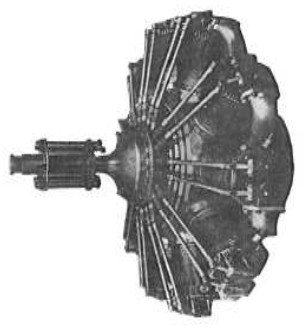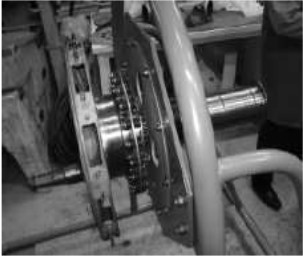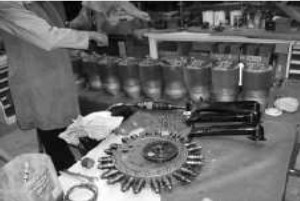Updated: 06-Jun-2018
In 1918 an ingenious, although complicated motor devised by L. Damblanc, tried to avoid the use of superchargers at high altitudes.
-It was a radial 11-cylinder engine with variable compression.

“Damblanc - Mutti”
-We provide a cross-section of the interesting 11-cylinder radial rotary engine.

“Esquema del Damblanc - Mutti”
-The variable compression of the Damblanc-Mutti was achieved by means of an eccentric in the neck of the crankshaft and that rotated by means of gear and a drive shaft that entered at the rear, through the center of the engine's support shaft together with the fuel mixture.
-While the shaft is rotating, the radius of the crankpin increases and therefore the piston strokes. The more altitude, the less chamber is increased, recovering the compression value.

"The crankpin eccentric varies the height of the piston"
From Appendix 6: Louis Damblanc was an engineer who designed a system capable of compensating for the loss of power from aviation engines at high altitudes.
-It was simple in appearance, even more so if it was used in a rotary radial engine in which the crankshaft was fixed, it was more possible to vary the height of the crankpin. (see Damblanc and Damblanc-Mutti).
-Normally, when climbing, an engine to 5,000 meters, generally in those times the engines lost half the power. With this system they maintained it up to 6,000 meters.
-They were successfully tested by the French Aviation Service. What happened is that other fixed engines appeared with supercharging and turbocharging systems that surpassed it.
-Also known as Damblanc only (see Damblanc-Mutti).
-In the engine-restoration workshop at the Safran Museum in Villaroche, the museum's technicians of the "Amical" are restoring -in 2008- a Damblanc that may be a unique piece and that will later be sent to the Air and Space Museum at Le Bourget.

“Damblanc picture via AEHS”

“Crank system details” (AEHS)
-The variation of the piston strokes was produced when raising or retracting the radius of the crankshaft neck.
-With this, the loss of the compression ratio at high altitudes was compensated.

“Variation mechanism of crankshaft radius”


“Photographs of the restoration process”
-Don't forget that it was an 11-cylinder rotary radial engine.
Engines of DAMBLANC - MUTTI
Model: 11 cils. radial rotativo, compr. variable
Arquitecture: 11-cylinder Rotary
Cooling: Air
Total Displacement: Unknown
Bore / Stroke: Unknown x Unknown
Power: Unknown
Weight:

"Damblanc - Mutti, radial"


